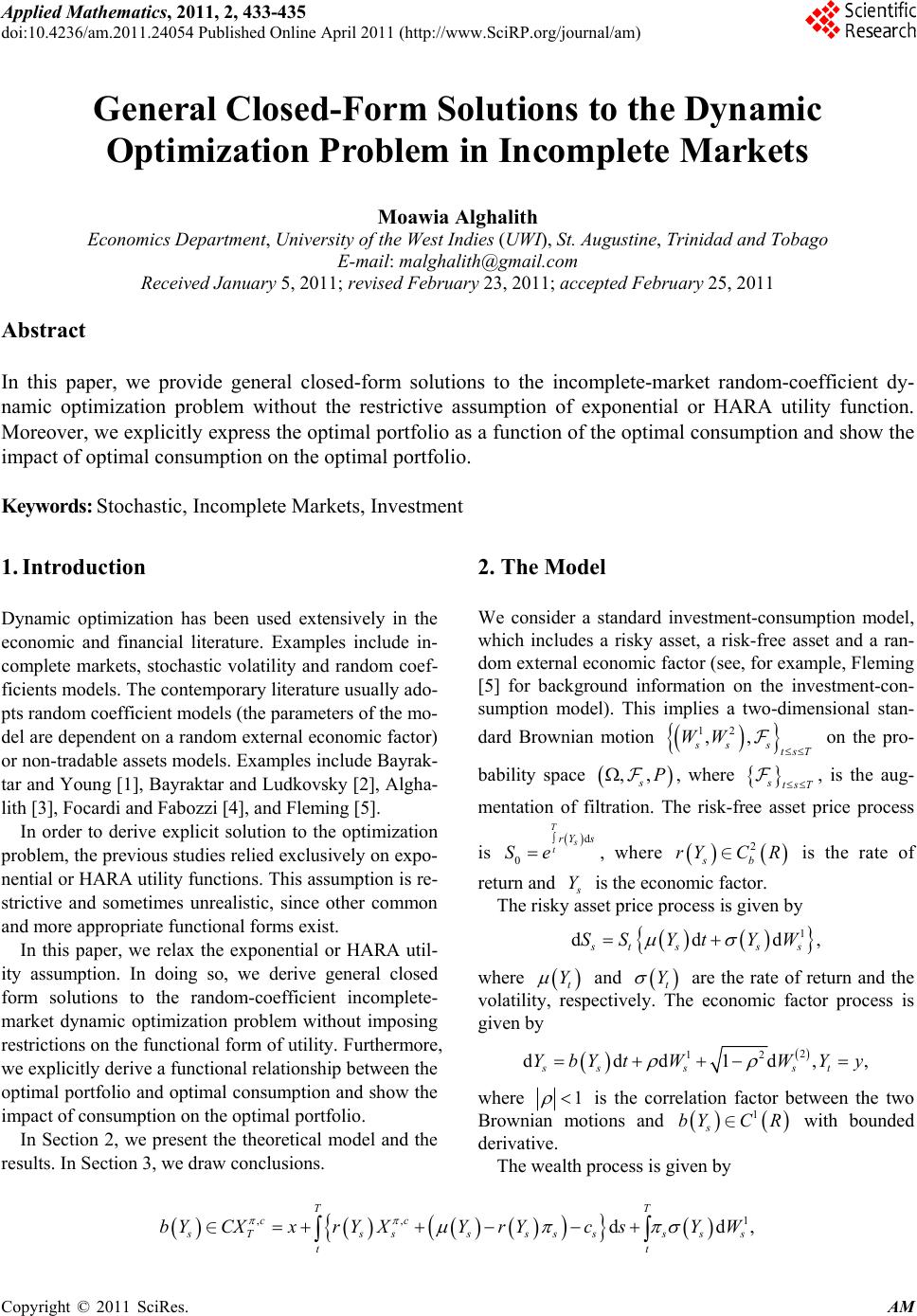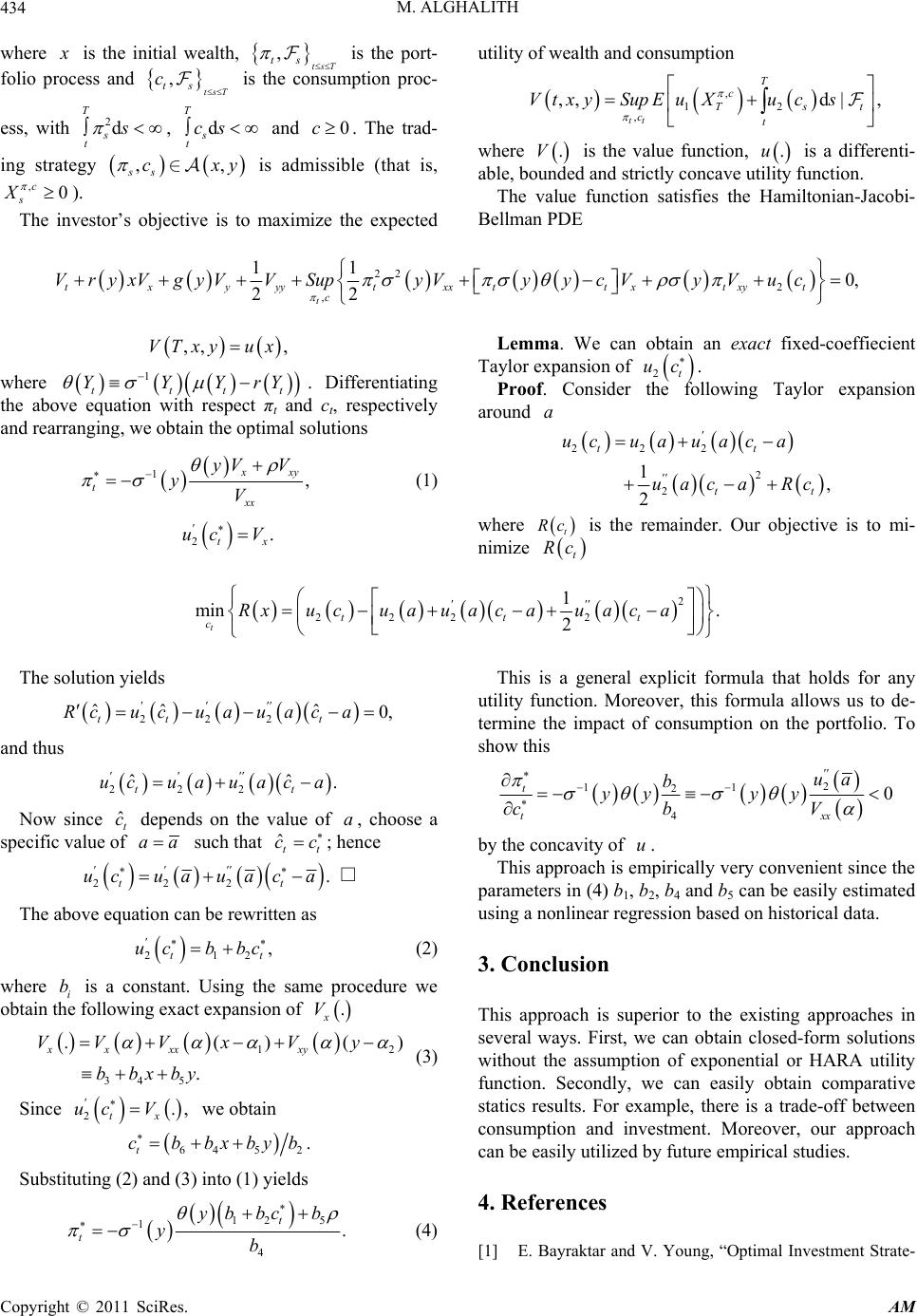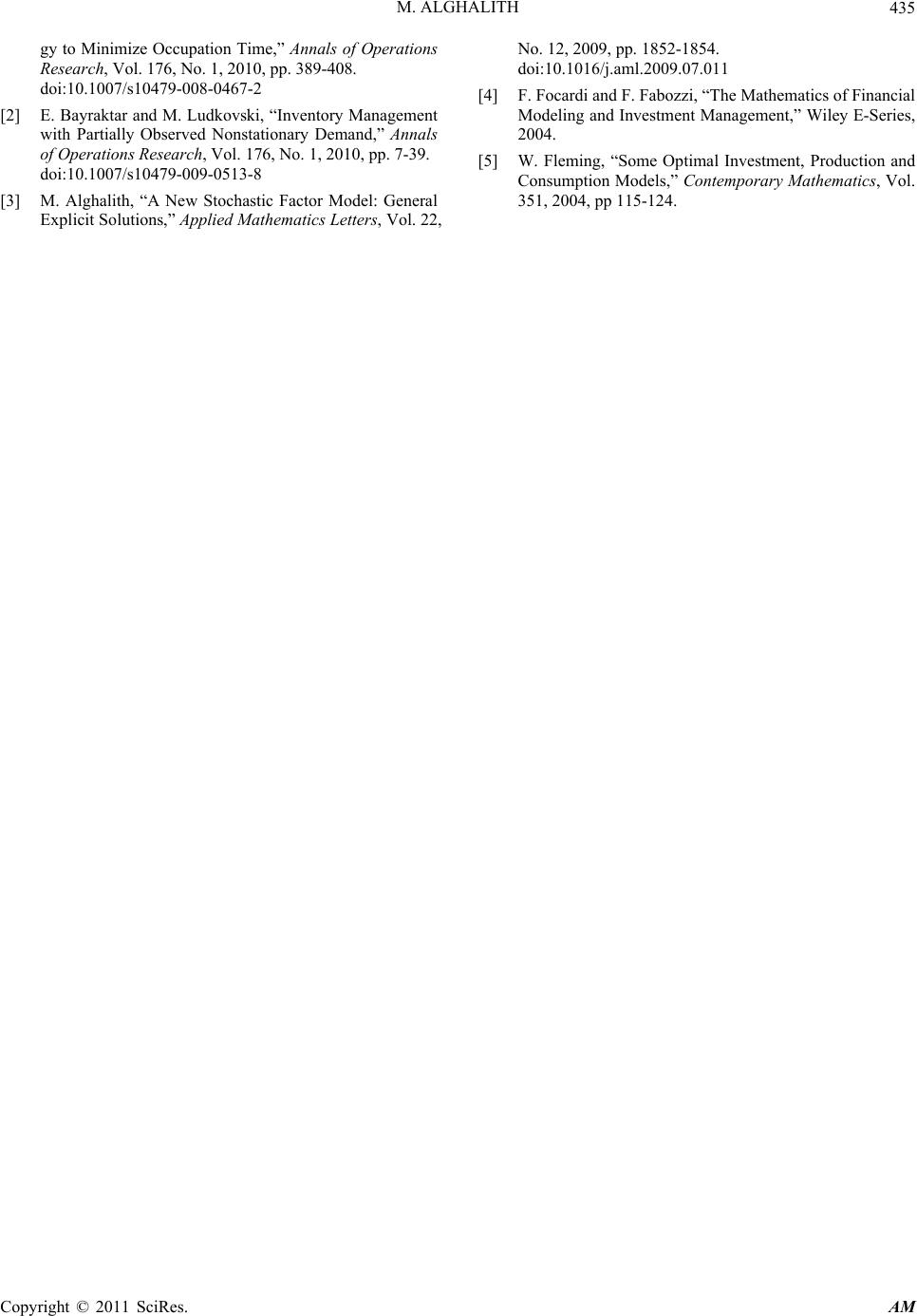Paper Menu >>
Journal Menu >>
 Applied Mathematics, 2011, 2, 433-435 doi:10.4236/am.2011.24054 Published Online April 2011 (http://www.SciRP.org/journal/am) Copyright © 2011 SciRes. AM General Closed-Form Solutions to the Dynamic Optimization Problem in Incomplete Markets Moawia Alghalith Economics Department, University of the West Indies (UWI), St. Augustine, Trinidad and Tobago E-mail: malghalith@gmail.com Received January 5, 2011; revised February 23, 2011; accepted February 25, 2011 Abstract In this paper, we provide general closed-form solutions to the incomplete-market random-coefficient dy- namic optimization problem without the restrictive assumption of exponential or HARA utility function. Moreover, we explicitly express the optimal portfolio as a function of the optimal consumption and show the impact of optimal consumption on the optimal portfolio. Keywords: Stochastic, Incomplete Markets, Investment 1. Introduction Dynamic optimization has been used extensively in the economic and financial literature. Examples include in- complete markets, stochastic volatility and random coef- ficients models. The contemporary literatu re usually ado- pts random coefficient models (the parameters of the mo- del are dependent on a random external economic factor) or non-tradable assets models. Examples include Bayrak- tar and Young [1], Bayr aktar and Ludkovsky [2], Algha- lith [3], Focardi and Fabozzi [4], and Flemin g [5]. In order to derive explicit solution to the optimization problem, the previou s studies relied exclus ively on expo- nential or HARA utility functions. Th is assumption is re- strictive and sometimes unrealistic, since other common and more appropriate functional forms exist. In this paper, we relax the exponential or HARA util- ity assumption. In doing so, we derive general closed form solutions to the random-coefficient incomplete- market dynamic optimization problem without imposing restrictions on the functional form of u tility. Furthermore, we explicitly derive a functional relationship between th e optimal portfolio and optimal consumption and show the impact of consumption on the optimal portfolio. In Section 2, we present the theoretical model and the results. In Section 3, we draw conclusions. 2. The Model We consider a standard investment-consumption model, which includes a risky asset, a risk-free asset and a ran- dom external economic factor (see, for example, Fleming [5] for background information on the investment-con- sumption model). This implies a two-dimensional stan- dard Brownian motion 12 ,, ss s tsT WW on the pro- bability space ,, sP, where stsT , is the aug- mentation of filtration. The risk-free asset price process is d 0 T s t rY s Se , where 2 sb rYC R is the rate of return and s Y is the economic factor. The risky asset price process is given by 1 ddd, stss s S SYtYW where t Y and t Y are the rate of return and the volatility, respectively. The economic factor process is given by 2 12 ddd1d,, ss sst YbYt WWYy where 1 is the correlation factor between the two Brownian motions and 1 s bYC R with bounded derivative. The wealth process is given by ,, 1 dd, TT cc s Tsssssssss tt bYCXxrY XYrYcsYW  M. ALGHALITH Copyright © 2011 SciRes. AM 434 where x is the initial wealth, ,tsT ts is the port- folio process and ,tsT ts c is the consumption proc- ess, with 2d T s t s , d T s t cs and 0c. The trad- ing strategy ,, ss cxy is admissible (that is, ,0 c s X ). The investor’s objective is to maximize the expected utility of wealth and consumption , 12 , ,,d| , tt T c Tst ct VtxySupEu Xu cs where .V is the value function, .u is a differenti- able, bounded and strictly concave utility function. The value function satisfies the Hamiltonian-Jacobi- Bellman PDE 22 2 , 11 0, 22 t txyyytxxttxtxyt c Vry xVgyVVSupyVyycVyVuc ,, ,VTxy ux where 1 tttt YYYrY . Differentiating the above equation with respect πt and ct, respectively and rearranging, we obtain the opti mal solu tions 1, x xy t xx y VV yV (1) 2. tx uc V Lemma. We can obtain an exact fixed-coeffiecient Taylor expansion of 2t uc . Proof. Consider the following Taylor expansion around a 222 2 2 1 , 2 tt tt ucuauac a uac aRc where t R c is the remainder. Our objective is to mi- nimize t Rc 2 222 2 1 min . 2 t ttt cRxucuauacauac a The solution yields 222 ˆˆ ˆ0, tt t Rcucuauaca and thus 222 ˆˆ . tt ucuauac a Now since ˆt c depends on the value of a, choose a specific value of aa such that ˆtt cc ; hence 222 . tt ucuauac a □ The above equation can be rewritten as 212 , tt ucb bc (2) where i b is a constant. Using the same procedure we obtain the following exact expansion of . x V 12 34 5 .()() . x xxxxy VV V xVy bbxby (3) Since 2., tx uc V we obtain 64 5 2 . t cbbxbyb Substituting (2) and (3) into (1) yields 12 5 1 4 . t t yb bcb yb (4) This is a general explicit formula that holds for any utility function. Moreover, this formula allows us to de- termine the impact of consumption on the portfolio. To show this 2 11 2 4 0 t xx t ua b yy yy bV c by the concavity of u. This approach is empirically v ery convenien t since the parameters in (4) b1, b2, b4 and b5 can be easily estimated using a nonlinear regression based on historical data. 3. Conclusion This approach is superior to the existing approaches in several ways. First, we can obtain closed-form solutions without the assumption of exponential or HARA utility function. Secondly, we can easily obtain comparative statics results. For example, there is a trade-off between consumption and investment. Moreover, our approach can be easily utilized by future empirical studies. 4. References [1] E. Bayraktar and V. Young, “Optimal Investment Strate-  M. ALGHALITH Copyright © 2011 SciRes. AM 435 gy to Minimize Occupation Time,” Annals of Operations Research, Vol. 176, No. 1, 2010, pp. 389-408. doi:10.1007/s10479-008-0467-2 [2] E. Bayraktar and M. Ludkovski, “Inventory Management with Partially Observed Nonstationary Demand,” Annals of Operations Research, Vol. 176, No. 1, 2010, pp. 7-39. doi:10.1007/s10479-009-0513-8 [3] M. Alghalith, “A New Stochastic Factor Model: General Explicit Solutions,” Applied Mathematics Letters, Vol. 22, No. 12, 2009, pp. 1852-1854. doi:10.1016/j.aml.2009.07.011 [4] F. Focardi and F. Fabozzi , “The Mathematics of Financial Modeling and Investment Management,” Wiley E-Series, 2004. [5] W. Fleming, “Some Optimal Investment, Production and Consumption Models,” Contemporary Mathematics, Vol. 351, 2004, pp 115-124. |

